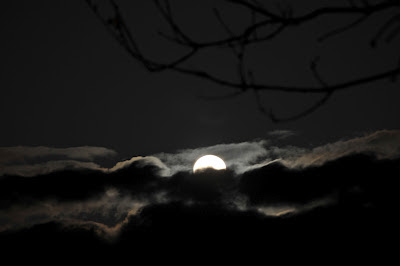One of the perks of my job is that I get to travel to unusual places. In fact, some of the places are more than unusual...they are downright remote and one can get the feeling of being in a different world, or a different time.
In mid-May I found myself in such a place, driving a lonely highway between Farmington and Gallup, New Mexico. As you can see, the road is long, straight and the scenery markedly different from the forests and fields of Oregon. But then, I like that. There is a certain beauty in the stark and desolate landscape.
This random outcropping is a lava intrusion in which the surrounding softer soil has eroded away. It was taken as I drove past. Thank goodness for autofocus and exposure control, so I can simply point and shoot with my camera. Most of the time it works out, and occasionally I get a great shot.
After my meetings and site visit (which was for a potential dam rehabilitation project at the end of this canyon), I took a slight detour and stopped by Canyon de Chelly (pronounced
de shay), near Chinle, Arizona. This is a spectacular canyon on the Navajo Reservation that has been home to indigenous people for more than 5,000 years, first the Ancient Pueblo People (also known as the
People of the Canyon, or Anasazi), and later the Navajo. The Navajo are also known as
Dine', or
Dineh.
There are many cliff dwellings scattered thoughout the canyon such as the one pictured above. Access was often only made by a series of ladders that afforded both protection from marauding tribes, as well as shade from the hot sun. (It was in the 90's and very windy during my visit, which is why many of the images have a slight haze.)
There are three main fingers of canyon that converge at the west end of the system. This one is named Canyon del Muerto, or Canyon of the Dead, so named for a prehistoric indian burial ground found in 1882.
More cliff dwellings, of which there are hundreds in the canyon. Only a dozen or so have been stabilized to prevent or minimize further deterioration, and only a select few are accessible to the public.
Part of the beauty of such a remote location is the stillness, despite the wind. As I sit and contemplate in a place such as this, I can almost feel the mystical presence of ancient ones, amidst the whistle of the wind, the screech of the hawk and the caw of the raven.
These are the White House Ruins, so named for the different stone used in the building in the center of the hole in the lower left of the photo. While most of the buildings used stone of the same reddish composition as the surrounding cliffs, this particular structure used a lighter colored stone. It isn't known why.
This is Spider Rock, a 750-foot sandstone spire formation. According to Pueblo and Navajo/Dineh tradition, the Spider Grandmother spun a web, laced it with dew, and then cast it into the sky thus forming the stars. She is said to live in the taller of the two spires
In the midst of the desert, there is a splash of color from the bloom of a cactus. I saw this peeking out from beneath a juniper shrub as I walked back to the car. If any of you botanical types know what this is, let me know and I will credit you in this blog.
When traveling in remote areas, one must often yield the right-of-way to pedestrians...especially 4-legged ones.
With the barren landscape stretching for hundreds of miles, it is no surprise that the wind can really pick up and carry dust as though in a blizzard. The wind gusted over 50 miles per hour and the sand blew across the road like small sand dunes. Driving back to Farmington was a bit of an adventure, and I was ready for the cooler and wetter climes of the Pacific Northwest.
For more information about Canyon de Chelly and the Navajo People, you can visit these sites:
http://en.wikipedia.org/wiki/Canyon_de_Chelly_National_Monument
http://en.wikipedia.org/wiki/Spider_Grandmother
http://en.wikipedia.org/wiki/Navajo_people














